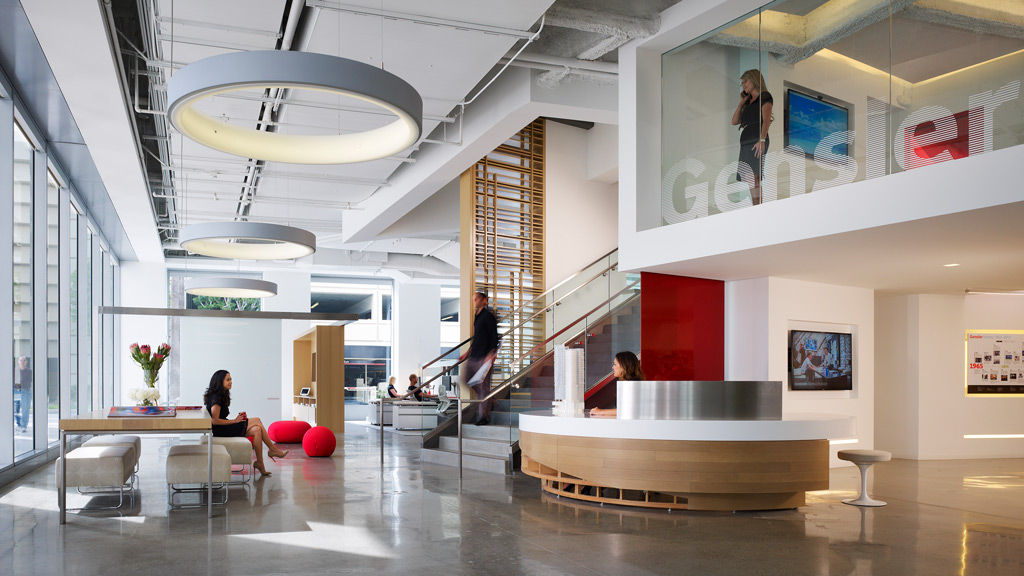Taking Care of Each Other in the Post-Pandemic Open Office
April 10, 2020 | By Brian Stromquist
Editor’s Note: This post is part of our ongoing exploration of how design is responding to the COVID-19 pandemic.
Like many of you, I’ve been getting to know a lot of my neighbors lately. We greet each other from the safety of second-story windows. We cautiously cross paths as we return from essential trips to the wine store. We shout words of encouragement as we improvise workout routines in adjacent backyards.
To the outside observer, it would seem like we’ve known each other for years. In many cases, however, these are my first substantial interactions with them in the more than 10 years that I’ve lived in my apartment. Yet here we all are, housebound by a global pandemic, brought together physically and spiritually in a way that looks and feels quintessentially neighborly.
These interactions underscore the very nature of the neighborhood as both a physical and behavioral construct — we’re occupying the same physical footprint and we’re behaving in ways that safeguard our collective health and wellness. Taking care of ourselves means taking care of each other, and vice-versa.
Bringing community to the open officeThis concept of community is helpful to keep in mind as we begin to imagine what it will be like to re-occupy the workplace following this pandemic. For years we’ve talked about “neighborhoods” in our open office workplace designs as a way to section off expansive floor plans and encourage collaboration. These were behavioral incubators as well, born from the idea that if employees or teams felt like they owned a portion of the workplace, that sense of ownership and pride-of-place would result in cleaner, higher-functioning work environments.
This time around, it’s going to take a lot more than a well-organized printer credenza to make us comfortable about returning to the office. The behaviors that we’ve adopted and honed these past few weeks — 20-second hand washing, physical distancing, sheltering-in-place — won’t be so easily cast aside once we’re given the all-clear to head back to work.
In parts of the world where the infection rate has significantly slowed and people are returning to work, office colleagues aren’t falling back into old patterns of handshakes and communal dining and lunchtime workouts at the company gym. Instead, they’re importing the artifacts that defined their day-to-day lives during quarantine: face masks, latex gloves, hand sanitizer, and a six-foot radius.
We’re innately social animals, and the in-person collaboration and knowledge sharing that office environments provide will often outweigh the comfort and security of home. It’s also where we do a lot of our best work — Gensler’s recently released U.S. Workplace Survey 2020 shows that that, when given the choice of where to work, people still prefer the office.
Granted, the circumstances are markedly different now, but the ability of the workplace to support productive work and social activity will endure. The specter of pandemic might have taken some of the shine out of the workplace, but it still presents itself as a far more safe and secure alternative to the other work environments such as coffee shops and coworking spaces.
The question, then, is how do we restore a sense of safety to the post-pandemic workplace?
In the past few days we’ve seen ideas for workplace redesigns that are based on architectural workarounds like allocating more private offices and increasing corridor widths. These solutions may address the immediate desire for physical distancing, but what impact would they have on the collective behavior of employees within a workplace? While they might offer you a sense of ease while you sit at your desk and circulate around the office, how do they fit into a holistic design approach that encourages communal care?
Re-enter the neighborhoodOnce we return to the office, we’ll need to transpose our newly discovered sense of community accountability back into the workplace.
As we begin to think about who will constitute our open-office neighborhoods and how large these groups will be, we could take a page from the anthropological concept of Dunbar’s Number.
Devised by the British anthropologist Robin Dunbar, the concept proposes a maximum social group size based on the brain’s ability to maintain relationships. Any group exceeding the maximum number — which averages out around 150 — runs the risk of splintering or collapsing. And within that maximum group size, there are a set of concentric “intimacy circles” for different relationships.
Of those intimacy circles, the workplace tends to operate at the scale of Close Networks (about 50 people) and Sympathy Groups (about 15 people). The reimagined workplace neighborhoods would likely fall in between these sets, bringing together a group of 30 or so colleagues whose relationships are more familiar than Close Networks but not as intimate as Sympathy Groups.
Creating accountability with practical stepsIf we follow Dunbar’s model, we’ll each have around 30 new neighbors, and the question then becomes, how do you begin to build a culture of care and accountability with these people?
The process will be just as dependent on change management as it will on interior design. While some of these employees will likely know each other well, be it from working on the same teams or socializing outside the office, others will be newer to the neighborhood.
To bring everyone into the fold, one could implement a series of getting-to-know-you exercises akin to Arthur Aron’s questions to generate interpersonal closeness. These questions could be easily customizable in ways to best suit specific industries, geographies, and demographics.
Once personal connections are established, then design components will play an important role in bolstering and reinforcing this newfound communal spirit. Shared neighborhood resources like storage units, collaboration tables, and lounge areas provide opportunities for group alignment on how these should be used and maintained. Cleaning protocols will play a large part in these conversations as well — especially given their importance to the prevention of virus and bacteria transmission.
Although the timing for our return to the office is uncertain, we can start thinking about neighborhood-centric design approaches as early as now. If we can design workplace environments that create bonds of trust among groups of 30, then we’re designing for the health and wellbeing of entire office ecosystems by default. In the meantime, while we’re chatting with our urban neighbors from the safety of upper-story windows, let’s take this opportunity to observe, practice, and implement behaviors that will be critical to our collective recovery and the future of work.
For media inquiries, email .

